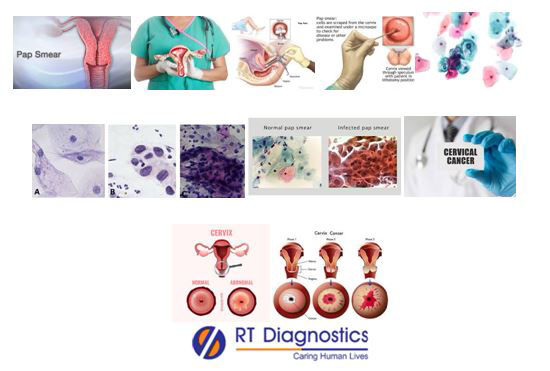Pap smear:
Why Pap Smear Test?
CLINICAL INFORMATION
The cervix is the lower, narrow end of the uterus located at the end of the vagina (a cylinder-shaped structure that connects the vagina and the uterus). After an abnormality has been found during a routine Pap smear (colposcopy-a special way of looking at the cervix using light and a low powered – compound microscope to make the cervix appear much larger) or pelvic examination (diagnostic evaluation), the gynaecologist may order a cervical biopsy. A cervical biopsy is a minor surgical procedure (in which a small amount of tissue is removed from the cervix) performed to confirm pre-cancerous (cells that appear to be abnormal, but not yet turned cancerous – are the first signs of cancer, that may develop years later) cells on the cervix. The gynaecologist may also perform a cervical biopsy to diagnose or treat certain conditions such as genital warts or polyps (non-cancerous growth of the cervix). Risk factors for developing cervical cancer are human papilloma virus - HPV (a DNA test for HPV is performed for confirmation). Types of cervical biopsies are punch biopsy, cone biopsy (conization), electric wire loop and endo-cervical curettage. Symptoms of cervical cancer – vaginal bleeding after sexual intercourse, irregular or heavy menstrual bleeding, pelvic pain or abnormal vaginal discharge like white discharge etc. Possible complications of cone biopsies include bleeding, infection vaginal tears, cervical stenosis due to scarring (causes impaired menstrual flow), narrowing of cervix and infertility. Conditions that may interfere and give less accurate results are menstruation, acute (active) pelvic inflammatory diseases and acute inflammation of the cervix. Do’s and do not's before the test – Do’s are emptying the bladder and bowel before the test, and do-not’s are do-not douche, do-not place any products in the vagina, do-not have inter-course for 24 hours before the test examination is performed. Other tests include examination of bladder and rectum, imaging tests such as CT scan, MRI or Ultrasound, histopathology studies etc.

General Instructions:
Sample Requirement: Specimen –Pap smear (Cervical Region). Test Preparation: None.
NOTE - Sample for specimen collections may vary based on the patient’s condition/cases according to the patient’s presenting complaints/signs or symptoms:
SPECIMEN REQUIREMENT (Special or Rare Cases) - As instructed and guided by Physician / Clinician / Pathologist / as per Laboratory’s requirements, according to procedures and protocols.
This Multi-Specialty Clinical Referral Laboratory RT DIAGNOSTICS provides precise and accurate tests with an extensive range of testing services to the medical centres to help in the diagnosis and identification of pathology in the test specimens for infectious diseases and also to evaluate the function of organ systems of the patient. It prevents further complications and helps to stabilize and restore health to near normalcy at the earliest without delay.



